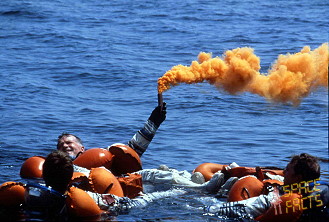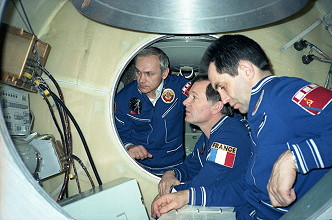Human Orbital Spaceflights
![]()
International Flight No. 82Soyuz T-6PamirUSSR |
 |
 |
![]()
Launch, orbit and landing data
walkout photo |
 |
|||||||||||||||||||||||
alternative crew photo |
alternative crew photo |
|||||||||||||||||||||||
alternative crew photo |
alternative crew photo |
|||||||||||||||||||||||
alternative crew photo |
alternative crew photo |
|||||||||||||||||||||||
Crew
| No. | Surname | Given names | Position | Flight No. | Duration | Orbits | |
| 1 | Dzhanibekov | Vladimir Aleksandrovich | Commander | 3 | 7d 21h 50m 53s | 125 | |
| 2 | Ivanchenkov | Aleksandr Sergeyevich | Flight Engineer | 2 | 7d 21h 50m 53s | 125 | |
| 3 | Chrétien | Jean-Loup Jacques Marie | Research Cosmonaut | 1 | 7d 21h 50m 53s | 125 |
Crew seating arrangement
|
 |
|
||||||||||||||||
Backup Crew
|
 |
|||||||||||||||||||||
alternative crew photo |
alternative crew photo |
|||||||||||||||||||||
alternative crew photo |
||||||||||||||||||||||
alternative crew photo |
||||||||||||||||||||||
Hardware
| Launch vehicle: | Soyuz-U (No. Ts15000-269) |
| Spacecraft: | Soyuz T-6 (7K-ST No. 9L) |
Flights
|
Launch from the Baikonur Cosmodrome and
landing 65 km northeast of Arkalyk. Following a one-day solo flight Soyuz T-6 docked manually with the Salyut 7 space station on June 25, 1982 because of problems with the automatic docking systems. Common work with the first resident crew was done. Several joint Soviet-French scientific research and experiments, including a series of French echography cardiovascular monitoring system experiments, were performed. Jean-Loup Chrétien was the first French and West European astronaut. While aboard the station, the resident crew afforded him the opportunity to eject Salyut 7's weekly bag of waste into space through the station's small trash airlock. Valentin Lebedev, writing in his diary, quoted Jean-Loup Chrétien as saying Salyut 7 "is simple, doesn't look impressive, but is reliable." All cosmonauts successfully carried out a comprehensive program prepared jointly by Soviet and French scientists with the participation of over 20 French research institutes and laboratories. A large part of the program was devoted to medical research into the effects of weightlessness on the human organism. The Echography experiment was carried out with the help of French ultrasonic equipment for a study of the heart's functions, the velocity of the blood flow through major blood vessels, and changes in the size of the latter during adaptation to zero gravity. In the Posture experiments the cosmonauts also studied the interaction between human sense organs and motor system. For the Neptune experiment the cosmonauts checked the sharpness and depth of vision, the sensitivity of the vision analyzer (the Mars-2 experiment), and the hygienic conditions on board Salyut 7 with two crew members present in the Microbe Exchange experiment. The cosmonauts also used a special prophylactic device, the Bracelet, to study the possibility of normalizing blood circulation in conditions of weightlessness. Of particular interest to scientists on the ground were results obtained in the Biobloc-3 and Cytos-2 experiments. The purpose of the Biobloc-3 was the study the effect of heavy cosmic particles on biological objects. The data obtained would extend contemporary knowledge of the effects of cosmic radiation, provide a measure for assessing the danger of cosmic irradiation for biological systems, and assist in providing adequate protection, which is particularly important on long-duration space flights. The Cytos-2 experiment was aimed at studying the vital activity of microorganisms during space flight and their response to various antibiotics. It was hoped the results obtained could be used in developing methods for the prevention and treatment of different infectious diseases that might occur during space flight. The crew also carried out three vital technological experiments - Gauge, Diffusion and Liquation - with the aid of a Soviet Crystal apparatus. The Gauge experiment consisted of checking the temperature field of an electric oven under various modes of operation, and the simultaneous registering of microacceleration forces along the station's axis. The Diffusion experiment was aimed at determining the diffusion coefficients of materials (copper and lead) in conditions of weightlessness. The Liquation experiment analyzed the effect of capillary forces on the formation of an aluminum-indium alloy. In other words, metals which do not blend under normal terrestrial conditions. This experiment was also of practical value for the production of new composite materials made up of components with considerably differing densities and melting temperatures. Trying to replicate their production on Earth is an extremely complicated process. The Soyuz spacecraft is composed of three elements attached end-to-end - the Orbital Module, the Descent Module and the Instrumentation/Propulsion Module. The crew occupied the central element, the Descent Module. The other two modules are jettisoned prior to re-entry. They burn up in the atmosphere, so only the Descent Module returned to Earth. The deorbit burn lasted about 3 to 4 minutes. Having shed two-thirds of its mass, the Soyuz reached Entry Interface - a point 400,000 feet (121.9 kilometers) above the Earth, where friction due to the thickening atmosphere began to heat its outer surfaces. With only 23 minutes left before it lands on the grassy plains of central Asia, attention in the module turned to slowing its rate of descent. Eight minutes later, the spacecraft was streaking through the sky at a rate of 755 feet (230 meters) per second. Before it touched down, its speed slowed to only 5 feet (1.5 meter) per second, and it lands at an even lower speed than that. Several onboard features ensure that the vehicle and crew land safely and in relative comfort. Four parachutes, deployed 15 minutes before landing, dramatically slowed the vehicle's rate of descent. Two pilot parachutes were the first to be released, and a drogue chute attached to the second one followed immediately after. The drogue, measuring 24 square meters (258 square feet) in area, slowed the rate of descent from 755 feet (230 meters) per second to 262 feet (80 meters) per second. The main parachute was the last to emerge. It is the largest chute, with a surface area of 10,764 square feet (1,000 square meters). Its harnesses shifted the vehicle's attitude to a 30-degree angle relative to the ground, dissipating heat, and then shifted it again to a straight vertical descent prior to landing. The main chute slowed the Soyuz to a descent rate of only 24 feet (7.3 meters) per second, which is still too fast for a comfortable landing. One second before touchdown, two sets of three small engines on the bottom of the vehicle fired, slowing the vehicle to soften the landing. |
Photos / Graphics
 |
 |
 |
 |
 |
 |
 |
 |
 |
 |
 |
 |
 |
 |
 |
 |
 |
 |
 |
 |
 |
| © |  |
Last update on June 24, 2022.  |
 |